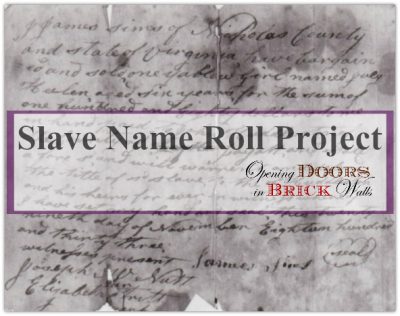Manumission is the term which may be applied to all the various processes by which negroes in Virginia were taken from a condition of slavery and legally raised to a status of freedom, saving only that act of the nation by which slavery was abolished in al the States and to which is properly applied the term emancipation. There are three general methods by which slaves in Virginia were manumitted or legally set free during the life of the institution of slavery: (1) by an act of the legislature, (2) by last will and testament, and (3) by deed. A still more general classification recognizes only two kinds of manumission–public and private, the first of the three methods above being classed as public manumission and the last two of the three bearing the name of private manumission.1
Elizabeth Squires chose manumission by last will and testament. Written in 1830 while she was living in Lewis County, (West) Virginia, the last will and testament of Elizabeth Squires was presented to the Braxton County court during the April term of 1840. Mrs. Squires’ residence remained the same. The area of Lewis County where she lived became Braxton County in 1836. She did not mention her children by name in her will. The purpose of her will was to free her two slaves, Sarah and her son Benjamin.2
The Last Will and Testament of Elizabeth Squires

I Elizabeth Squires of Lewis County do hereby make my last will and testament in manner and form following that is having been desirous for some years past that my negro woman Sarah and Benjamin her son should be Emancipated and to the enjoyment of their freedom I therefore Bequeath that my negro man Benjamin and Sarah his mother be set free and forever hereafter to enjoy their freedom as others in like circumstances and that none of my children or heirs to the estate may never after my death set up any pretended claim to the said negroes Sarah and Benjamin and that Benjamin under the aforesaid consideration be requested and further compeled to keep find and support his mother Sarah while they should live, having left the said Benjamin and Sarah his mother in the County of Faquier (sic) (where they now live) when I moved to this County and having been made somewhat acquainted of the difficulties of Emancipating Slaves in this State request the County Court of Faquier (sic) after this being recorded in Lewis to grant the permission of it in that was that may most promote the enjoyment of their freedom. I witness whereof I have hereunto set my hand and affixed my Seal this 28th day of June 1830.
………………………………………………………………….Elizabeth Squires (her mark)
Signed Sealed published and declared
by Elizabeth Squires as and for her last will
and testament in the presence and hearing
of us who at her request and in her
presence have subscribed our names as
Witneses
Elijah Squires
Shadrack Chaney
Asa Squires
Braxton County court April term 1840
The last will and testament of Elizabeth Squires was presented in court proven by the oathes of Asa Squires & Elijah Squires two subscribing witnesses and admited to record.
……………………..Teste (signature illegible) C.B.C. [Clerk Braxton County]
Elizabeth Squires died ten years after she wrote her last will and testament in which she desired to have her slaves Benjamin and his mother Sarah manumitted. She left them in Fauquier County when she moved to Lewis County were her two youngest sons Elijah and Asa lived. She was enumerated in Lewis County in 1830 in her son Asa Squires’ household in the age range 80 to 89 years.3 She died shortly before her 94th birthday.
Elizabeth Squires’ last will and testament was the first will in Will Book 1 of Braxton County with names of enslaved persons. Both of her sons who lived in Braxton County owned slaves and named them in their wills in 1854 and 1858. They will be shared in the next two Slave Name Roll Project posts.
 Following my three-part series on the slaves of my 5th great grandfather James Sims during Black History Month in February 2015 I made a commitment to write a post on a monthly basis until I’ve RELEASED all of the names of slaves owned by my ancestors or owned by persons I’ve researched who were relatives or neighbors of my ancestors.
Following my three-part series on the slaves of my 5th great grandfather James Sims during Black History Month in February 2015 I made a commitment to write a post on a monthly basis until I’ve RELEASED all of the names of slaves owned by my ancestors or owned by persons I’ve researched who were relatives or neighbors of my ancestors.
These posts are part of the Slave Name Roll Project (About the Project) administered by Schalene Jennings Dagutis who also blogs at Tangled Roots and Trees.
© 2018, copyright Cathy Meder-Dempsey. All rights reserved.
- John Henderson Russell, The Free Negro in Virginia, 1619-1865, Baltimore: The Johns Hopkins Press (1913), 42. ↩
- “West Virginia Will Books, 1756-1971,” database with images, FamilySearch (https://familysearch.org/ark:/61903/3:1:9392-HYL7-9?cc=1909099&wc=Q8BW-MZL%3A179688701%2C179712101 : accessed 30 June 2018), Braxton > Will book, v. 001 1836-1854 > image 24 of 177; county courthouses, West Virginia. ↩
- 1830 U.S. Federal Census, (index and images), Ancestry, citing Fifth Census of the United States, 1830 population schedule, National Archives and Records Administration, Washington D.C. NARA microfilm publication M19, 201 rolls, NARA Roll M19_191, FHL Film 0029670, Virginia, Lewis, images 59-60 of 74, page 256, line 22, Asa Squires. (http://www.ancestry.com : accessed 30 June 2018). ↩





Cathy, After watching “Who Do You Think You Are” and “Finding Your Roots”, this was a sometimes common practice to give slaves their freedom, correct? Enjoy reading your posts. Brian
LikeLiked by 1 person
Manumission by last will and testament may have been a more common practice for people who wanted to free their slaves than doing it by deed. When done by will more than one person could be freed while by deed it was usually for only one person. There were also other laws to consider. For example, a freed slave had to leave the state or a petition had to be draw up to allow residence in the county or state. I believe both may sound common as these are the records we are finding. Thank you, Brian.
LikeLiked by 1 person
Thanks Cathy. I always learn something new from you.
LikeLiked by 1 person
You’re welcome, Brian.
LikeLike
I hope that the children weren’t able to somehow violate the will and keep them enslaved—do you know? And wow, to live to 94 back then must have been really unusual. I bet Benjamin and Sarah were hoping that Elizabeth wouldn’t hang in there that long!
LikeLiked by 1 person
Thank you, Amy. I also wondered who Elizabeth left Benjamin and Sarah with and if they knew she had been thinking of manumitting them.
As this is not one of my families, I did not research all of her children. However, it appears Asa and Elijah were her youngest and went to Harrison County (from which part became Lewis and from which part became Braxton) before 1810.
Not only did she live long, her widowhood lasted over 50 years as she lost her husband around the time her youngest was born in 1787.
LikeLike